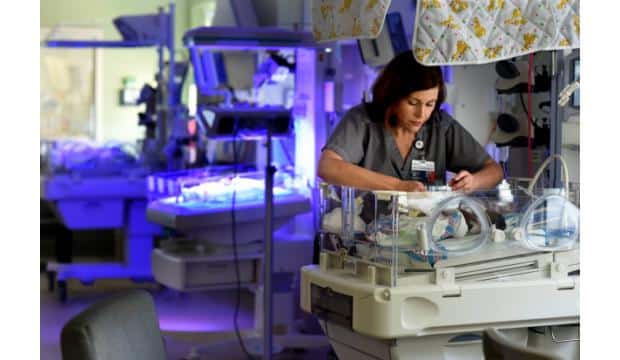Georgia continues to rank low in annual survey of well-being for children
Print This Post
Photo by The Augusta Chronicle
by Tom Corwin
Staff Writer—The Augusta Chronicle
There was no clue that there would be anything wrong with little Annie Miller until after she was born. Now, after nearly five months in the Neonatal Intensive Care Unit at Children’s Hospital of Georgia, her mother, Erin, is beginning to appreciate what is known as the “rollercoaster” families experience when their small, frail children fight to heal there.
“One day you’re fine,” Miller said, “the next day you’re not sure if your child is going to make it or not.”
Georgia’s high prevalence of low-birthweight babies, some of whom end up in the unit, is one reason the state continues to rank near the bottom in terms of child health and child welfare in the annual KIDS COUNT Data Book produced by the Annie E. Casey Foundation.
Georgia ranked 42nd overall for the second year in a row, 38th in health, 34th in education but 44th in economic well-being.
The percentage of low-birthweight babies at 9.5 percent in 2015 is little changed from 2010 and well above the national average of 8.1 percent.
While the state has made significant improvement in reducing teen births from 41 per 1,000 to 26 per 1,000, other measures such as children living in single-parent families or in high-poverty areas have actually increased since 2010.
It is difficult to say why Georgia would rank high in low-birthweight because there are multiple causes that could increase that risk, said Dr. Jatinder Bhatia, chief of neonatology at Medical College of Georgia at Augusta University.
One is a mother who is suffering from chronic health problems, such as high blood pressure or diabetes, he said. Another is prenatal care or the lack thereof, Bhatia said.
“Involvement in appropriate prenatal care and counseling goes a long way,” he said. “We have a lot of ‘no prenatal care’ or ‘limited prenatal care’ (babies). But as a state I cannot answer the question why Georgia ranks poorest on prematurity, on infant mortality and low birthweight. I don’t have an answer for that.”
The state already spends millions caring for medically fragile babies and the children’s hospital and NICU serve as part of a regional perinatal system designed to move babies needing more care from other regions to centers like the one in Augusta that can provide that care, Bhatia said. That is becoming more apparent as fewer and fewer hospitals deliver babies or provide prenatal care.
“We now in Augusta have become an oasis as birthing hospitals around us are closing,” Bhatia said. “If they don’t go to public health, if they don’t have birthing hospitals, then we have higher risk factors” for low-birthweight.
While Annie would have qualified as low-birthweight at 4 pounds, 11 ounces, she would have been fine had she not had a rare birth defect where her esophagus and larynx were together instead of being separate, Erin Miller said. That required surgery and months of recovery in the NICU, where she remained Monday. Even when she seemed to be doing better and was on the verge of being able to come home, she caught a virus and her parents feared she might not make it, though it appears to have passed, Miller said.
She wants parents to know that they need to advocate for their children, to do research and make sure they are getting the best for their children. And those who have had healthy babies they are able to take home a day or two later with them should not take that for granted.
“My child will be five months old on Monday and the only outside she’s ever seen was on the helicopter ride here,” Miller said. “We didn’t even get to hold her for the first two months of her life.”
Still, when she has seen what other families have suffered, she is grateful for where Annie is now.
“We’re very fortunate that ours has made it this far,” Miller said.
^
Reach Tom Corwin at 706-823-3213
Read the story on chronicle.augusta.com.
